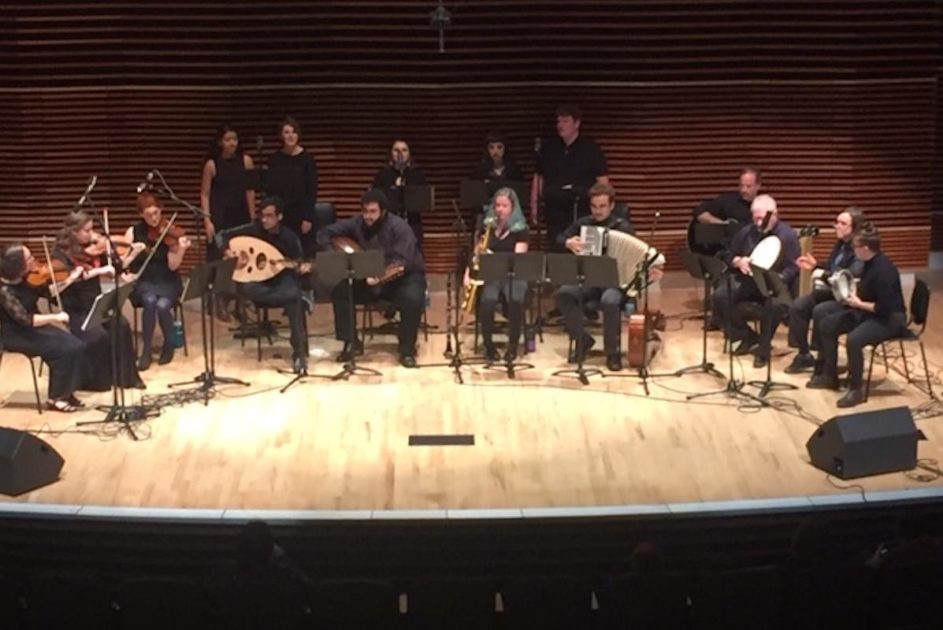The music of other regions and cultures around the world can sound strange to American ears that may have never heard it. At the University of Tennessee School of Music Saturday night, the school’s Middle East Ensemble, directed by Dr. Lillie S. Gordon, presented its fall concert with music from Egypt, Saudi Arabia, Persia and Lebanon, as well as music from Greece and the Sephardic Jewish community of the Black Sea area.
In addition to Gordon, a musicologist at the school who specializes in Arabic music, the ensemble is made up of students, alumni and community members. They play mostly familiar instruments: violin, cello, saxophone, accordion, tambourine and electric bass guitar.

Oud player Abdullah Algamdi with his instrument
They also have instruments seldom seen in America like the oud, a stringed instrument with a big round back and a bent neck similar to a lute, and a couple of important hand-played drums – a bodhran, similar to the Irish flat hand drum; and a doumbek, similar to the African djembe, but played with the hand and fingers instead of a curved stick.
The tambourine, bodhran and doumbek are essential instruments because they set the tempo and the rhythms.
Middle Eastern music has much more complex rhythms than almost all popular American and British music. The Jewish tune of the Sephardic Black Sea community, for instance, had a rhythm pattern of 1-2-1-2-1-2-3.
The Sephardic music goes back to the Jewish communities in Spain in the 15th and 16th centuries. “Las Esuegras de Agora” is a silly, conversational song sung by Elena Tajuelo Rodriguez. It tells a story of warning about mothers-in-law, told by the son-in-law, his wife and, finally, the mother-in-law herself. But she turns it into complaints about today’s young lovers.
It has haunting melodies played by Emily Williams’ violin and Dakota Johnson’s accordion, along with a part-whiny/part-sultry clarinet solo played by Anna Helms.
“Laylat Khamis” is a famous Saudi song written by ‘Amr Kadras and made famous by the singer Muhammad ‘Abdu. It celebrates Thursday night, the night before the beginning of the weekend on Friday in the Muslim world. As Elizabeth Geist sang, the moonlight decorated happy meetings between young lovers.
The Egyptian song “Ahu Dalli Sar” (“This Is What Happened”), written by Sayyid Darwish, who set the tone for contemporary Egyptian music, poses the question of who should be blamed for social problems and how to unite for common causes.
“A Wasla in Maqam Rasi” is a suite of improvisations and songs played throughout the Eastern Arab world. On one of the songs, “Ya Shadi il-Alban,” another Darwish composition, oud player Abdullah Algamdi played an extended, improvised solo, followed by an improvised solo by Gordon. Then singer Isaiah Green sang about calling a bird to bring good news of his beloved. He followed with a song about pleading with a young, beautiful Damascene girl to come back into his life.

Classical Arabic dancer Shannon Meyer
In addition to all this, guest classical dancer Shannon Meyer performed dances, including a Persian dance set to the contemporary Iranian song “Azizam.” It implores the jilted and brokenhearted to not grieve because life is beautiful.
Although the rhythm patterns in this music change from country to country and tune to tune, the tempos move along in a fairly even pace like much of American folk music. But listening to it can transport one to a different time and place.
Most of the music on the program was traditional cultural and folk music of the Middle Eastern area. Walking the streets of Cairo or Amman, one certainly hears this music coming from the cafés where, often, a lone musician sits on a stool playing an oud and singing.
Going along the streets, it gets mixed with the English-language pop music one can hear on radios around most of the world.
For more about ethnic and cultural music presented at UT, check the school’s website.

